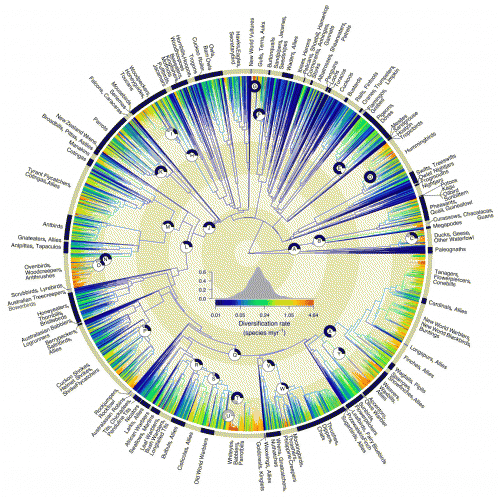First ever family tree for all living birds reveals evolution and diversification

The world's first family tree linking all living bids and revealing when and where they evolved and diversified since dinosaurs walked the earth has been created by scientists from the University of Sheffield.
Experts used the family tree to map out where the almost 10,000 species of birds live to show where the most diversification has taken place in the world.
Researchers, from the University of Sheffield, Yale University, University of Tasmania and Simon Fraser University, say the creation of new species has speeded-up over the last 50 million years. Surprisingly, species formation is not faster in the species rich tropics, but was found to be faster in the Western Hemisphere compared to the Eastern Hemisphere as well as on islands.
As well as being the first time scientists have created a family tree for birds, it is hoped the research could help prioritise conservation efforts in a bid to save the most diverse species from extinction.
Dr Gavin Thomas, of the University of Sheffield's Department of Animal and Plant Sciences, said: "We have built the first ever family tree showing the evolutionary relationship among the species of birds. We used fossils and genetic data to estimate the ages of all the different branches of the bird tree so that we could assess how diversity has accumulated through time. Our work is indebted to researchers from museums and universities who have collected astounding amounts of genetic data from birds around the world."
Despite major steps forward in modern super computers it has still taken the researchers almost five years to analyse the millions of year's worth of fossil data, DNA, maths and maps, to create this never-before-snapshot of how the thousands of birds alive made it to where they are today.
To even enable the scientists to calculate which species were more or less diverse they had to create a new "species rate" measure.
Dr Thomas added: "Diversification is the net outcome of new species arising, called speciation, and existing species going extinct. We combined this data with existing data on the geographic ranges of all living bird species so that we could map diversification across the world.
"This 'phylogeny' is important because it is the first that includes all living birds. It means we can ask questions about biodiversity and evolution on a global scale and gain new insight into how diversity has changed over millions of years as well as understand those changes. More widely, one way in which the phylogeny can be used, and which may not be obvious, is in helping to prioritise conservation efforts.
"We can identify where species at greatest risk of extinction are on the tree and ask how much distinct evolutionary history they represent. Some species have many close relatives and represent a small amount of distinct evolutionary history whereas others have few close relatives and their loss would represent the disappearance of vast amounts of evolutionary history that could never be recovered. Environmental change has very likely affected diversification over time. Climate change could be a part of that through its effects on the extent of different types of habitat."
The paper – titled 'The global diversity of birds in space and time' - is published in the journal Nature.
Journal information: Nature
Provided by University of Sheffield



















